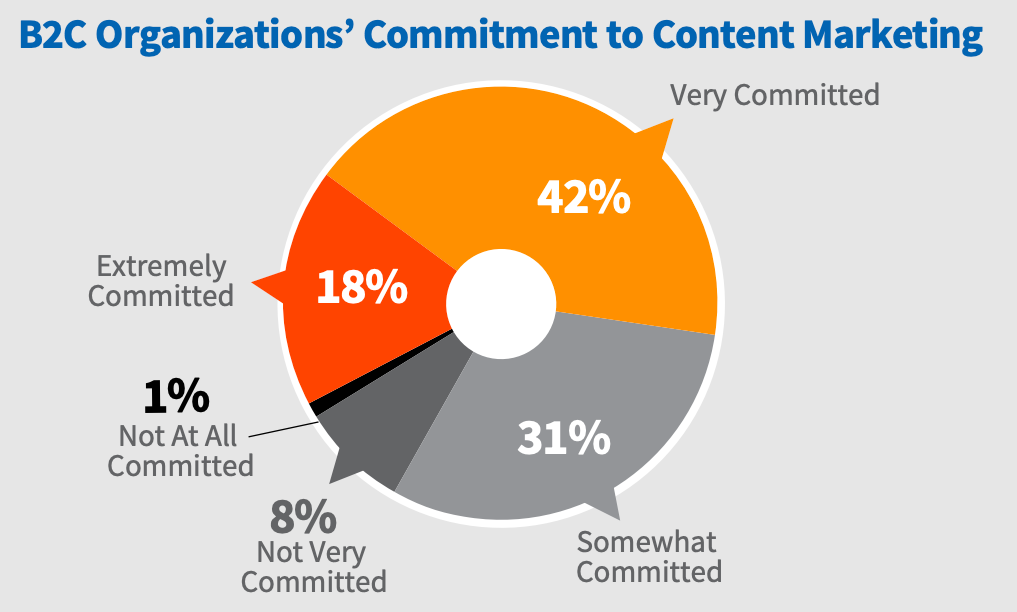So you have a great product or service to offer. It can solve some really complex issues for people, so it should sell pretty well.
The only problem is, and I’m going to be brutally honest here, that your potential customers don’t know anything about you, and most of them don’t care.
To get your message across and turn a lead into a paying customer, you need content. It’s suitable for every major marketing goal, including raising brand awareness, increasing sales, fostering brand loyalty, and keeping a company on top of customers’ minds.
Perhaps unsurprisingly, 86 percent of marketers use content marketing, according to a recent report by Content Marketing Institute. Moreover, 60 percent of them report being either “very” or “extremely” committed to using this strategy.

B2C Content Marketing 2018: Benchmarks, Budgets, and Trends—Content Marketing Institute. Credit: Content Marketing Institute
However, despite a wide adoption and lots of love from digital marketers and companies, content marketing remains a pretty difficult strategy to master. Indeed, reaching success with content for eCommerce businesses requires thorough research and continuous implementation, which, in turn, calls for a serious commitment.
If you’re also puzzled with what content types to create and how to do the strategy right, this guide for eCommerce businesses will help with taking care of that.
The first step in making your future content marketing work is planning. Obviously, there are a lot of things to cover here, including but not limited to the following:
Often, businesses document their content marketing strategy, which marks the end of the planning stage. As research discovered, having a documented content marketing turns out to be a factor that separates successful businesses from their less successful counterparts.
In fact, 59 percent of the most successful digital marketers reported having a documented strategy, while only 18 percent of the least successful ones could say the same.
Here are the complete results, courtesy of Content Marketing Institute.

Credit: Content Marketing Institute
But how exactly having a documented strategy can help an eCommerce business to connect with customers? Well, there are a few good answers to that.
So, having a documented strategy has a lot of benefits for eCommerce businesses and provides them with a clear vision of how to achieve their marketing goals.
In fact, when asked about the benefits of a documented strategy in the latest Content Marketing Institute survey, the marketers had a lot to say. Take a look.

B2C Content Marketing 2019: Benchmarks, Budgets, and Trends—Content Marketing Institute/MarketingProfs. Credit: Content Marketing Institute
This is surely something that any eCommerce businesses and their marketing teams can benefit from, right? That’s why being strategic and consistent about content planning is so important in eCommerce today.
So, what should you consider during the planning stage that could improve the performance of a content marketing strategy?
In this section, let’s consider five excellent content strategies that help to cover all bases and maximize the chances of high exposure to the intended audience.
Almost every decision you make in content marketing depends on your target audience. Strategizing is not an exception here. Knowing who your target audience is, what problems they’re facing, and how you can help them allows taking a more targeted approach.
One way to research your target audience is to take a look at your existing customer base as well as the most popular content that you already have.
For example, your Google Analytics could be a goldmine of data. To see the conversion rate for your traffic, click on a goal under the Explorer or Map Overlay tab. There, you’ll also see the following information that could be useful:
Also, take a deep dive into your customer website behavior, purchasing history, shipping history, the most common service requests, interests, and other buyer-related information you may have.
This is a big one.
Ecommerce businesses have long realized that content like product-related blog posts rank much easier on Google than product pages, so they invest a lot in content production. This results in terabytes of content being published every day by competing companies, so breaking through the noise and getting to your target customers could be extremely hard.
“Content scheduling has emerged as a method for maximizing the chance of exposure to target audiences, especially sharing on social media,” says Ann Manning, a social media marketing expert from Top Writers Review. “The goal here is very simple: by publishing content when an intended customer is online and active, you get a better chance that your content will be read/viewed.”
Of course, this requires knowing when your target audience is the most active online. The best example of the importance of scheduled content publishing is social media. It’s commonly recommended for retail brands to publish content around lunchtime on:
At this time, many people tend to explore posts on Instagram and other social media networks while eating.
Many have tried to identify the best times to post on social media to maximize engagement. For example, this research suggests the following times that generate the most engagement:
Facebook: between 11 am and 1 pm (lunchtime, remember?) on Wednesday and Thursday

Source: Sprout Social
As for Instagram, Wednesday has also generated the most engagement for social media posts, with Friday being second best.

Source: Sprout Social
However, these results are just a suggestion, so finding out the best times to post for each specific business is something you’d have to figure out by yourself. But, you’re welcome to use these as a starting point.
As for content on eCommerce blogs, there’s no universal formula on best publishing times as well. If we take a look at how often blogs share content, we’ll see that most of them publish several posts per month.

Frequency of publishing content publishing. Source: OrbitMedia
Evidently, many also publish content once per week and between two and six times per week. However, when asked about what frequency provides the best results, those who published one post or more daily generated the most engagement.

Source: OrbitMedia
But does this mean that you should follow this strategy and spend most of your time writing posts on your eCommerce blog? Well, no. Every business has its own content production capabilities, so if yours are limited to writing one article or shooting one short video per week, then that’s what you should do. With time, you’re surely going to share more, as your business grows.
On the other hand, if you’re fortunate enough to be able to produce more than one content piece for your blog weekly, then go for it. Well-established blogs typically produce tons of content to keep their audiences engaged and website traffic high; for example, Hello Fresh blog shares 10 articles with cooking recipes and tips monthly.

Source: Screenshot, HelloFresh Blog
But publishing so much content is something that a company with 1.3 billion euros in annual revenue can afford.
So, to sum up, scheduling your content publishing is a good idea to ensure consistency and increase the chance of higher exposure. During the planning stage, you should definitely consider the best potential times to share content on social media, but be realistic about your ability to produce content.
Social media is a must for eCommerce businesses because it has a great ability to influence their decisions. In fact, 74 percent of online shoppers make purchasing decisions based on social media posts and reviews of influencers and friends.
By sharing content such as announcements, product updates, sales, and blog articles on social media, you can:
No wonder that most of the eCommerce businesses have official profiles on such platforms as Instagram and Facebook. Zara, for example, shares a lot of product-related posts on Facebook; here’s one showing a product from the latest collection.

Source: Zara official, Facebook
Another well-known eCommerce clothing seller, Rue La La, uses Facebook to share news related to fashion. The post below, for example, talks about Megan Markle’s Carolina Herrera handbag and leads the reader to the company’s blog where they can sign up for a newsletter.

Source: Rue La La official, Facebook
Sharing news and product-related posts are not the only use cases for social media in eCommerce. You can also conduct customer surveys, invite followers to events, and even share news and humor from the industry. With Twitter, Facebook, and Instagram's analytics tools, tracking the performance of campaigns and measuring traffic to your website has also become an easy task.
To evaluate performance, use link tracking tools to monitor clicks.
Taking care of ever-changing SEO requirements is another important task for any content producer. To make sure that Google and other search engines can understand your content and index it, you have to make it easy for them. For example, Google has multiple guides on content creation that can be helpful.
Here are some of the most important SEO considerations for eCommerce content producers:
Google Analytics and Google Search Console are must-have tools that can help with getting your SEO right. The list of SEO tips above is non-exhaustive, so check out 16 more SEO tips in this guide.
We’ve mentioned some eCommerce content types until this point, so let’s talk about your options in more detail. Before we get to any specifics, let me tell you that the best-performing eCommerce content is the one that has the most value to the consumer.
Here’s what I mean.
Up to 87 percent of customers now start product search and research online. However, only 28 percent begin from specific marketplaces like eBay and Amazon.
This means that many people don’t know which specific product they want, so they’re looking for information that can help them with making a good choice. They get such information from content like both textual and video-based product reviews, comparisons, and tests.
In fact, the State of Video Marketing report found that 96 percent of consumers say that an explainer video has helped them to learn more about a product or service. And watching video is not a casual part of product research, as 68 percent of consumers say it’s their most preferred content type for this purpose, says the same report.

Source: The State of Video Marketing report 2019, Wyzowl
An explainer video, therefore, has a lot of value for online shoppers looking for information, so that’s why videos remain one of the best-performing eCommerce content types.
All right, now let’s give you the list of content types that have the potential to provide a lot of value for online shoppers:
Once again, be realistic about your content production capabilities, but try to invest in making your content strategy as diverse as possible.
Clearly, investing in different content types can make your online store a popular destination for product research for many people, so it’s certainly worth trying (especially when 82 percent of consumers feel positive about a company after reading custom content it produced).
Content production and marketing are complex, so there are a lot of mistakes to be made. To help you avoid the most common one committed by eCommerce businesses, I’ve compiled this list with a concise explanation of each mistake.

Source: Screenshot, Timberland.com
If you’ve gotten this far, this means that you’re serious about your content strategy. This is great, as you already know that commitment and consistency are some of the most important factors that lead to success here. Hopefully, the tips and techniques described in this guide will be a major part of your content strategy! Feel free to apply them and don’t forget to track your results to focus on something that performs the best.
Content marketing guru at Mailmunch. I’m passionate about writing content that resonates with people. Live simply, give generously, stay happy.
Tags:

Hamna Abid
July 11, 2023

Hamna Abid
June 23, 2023

Ammar Mazhar
May 30, 2023